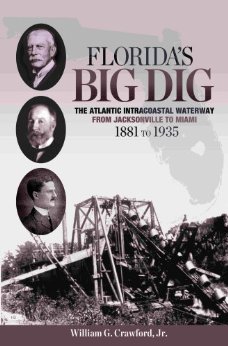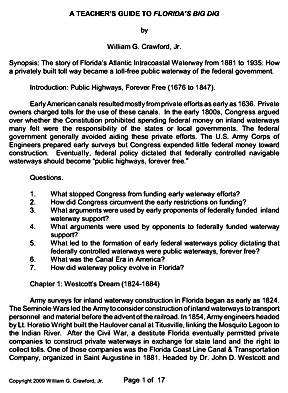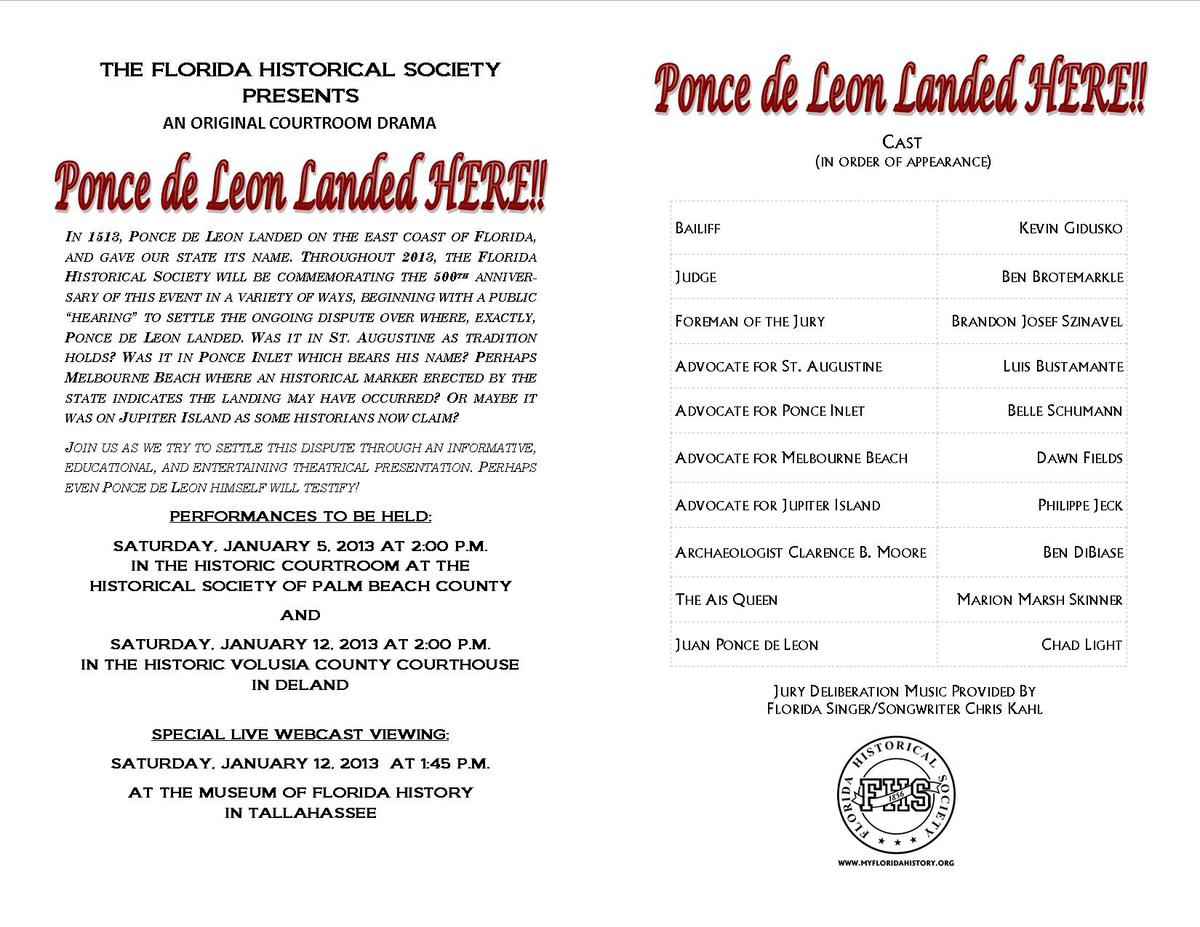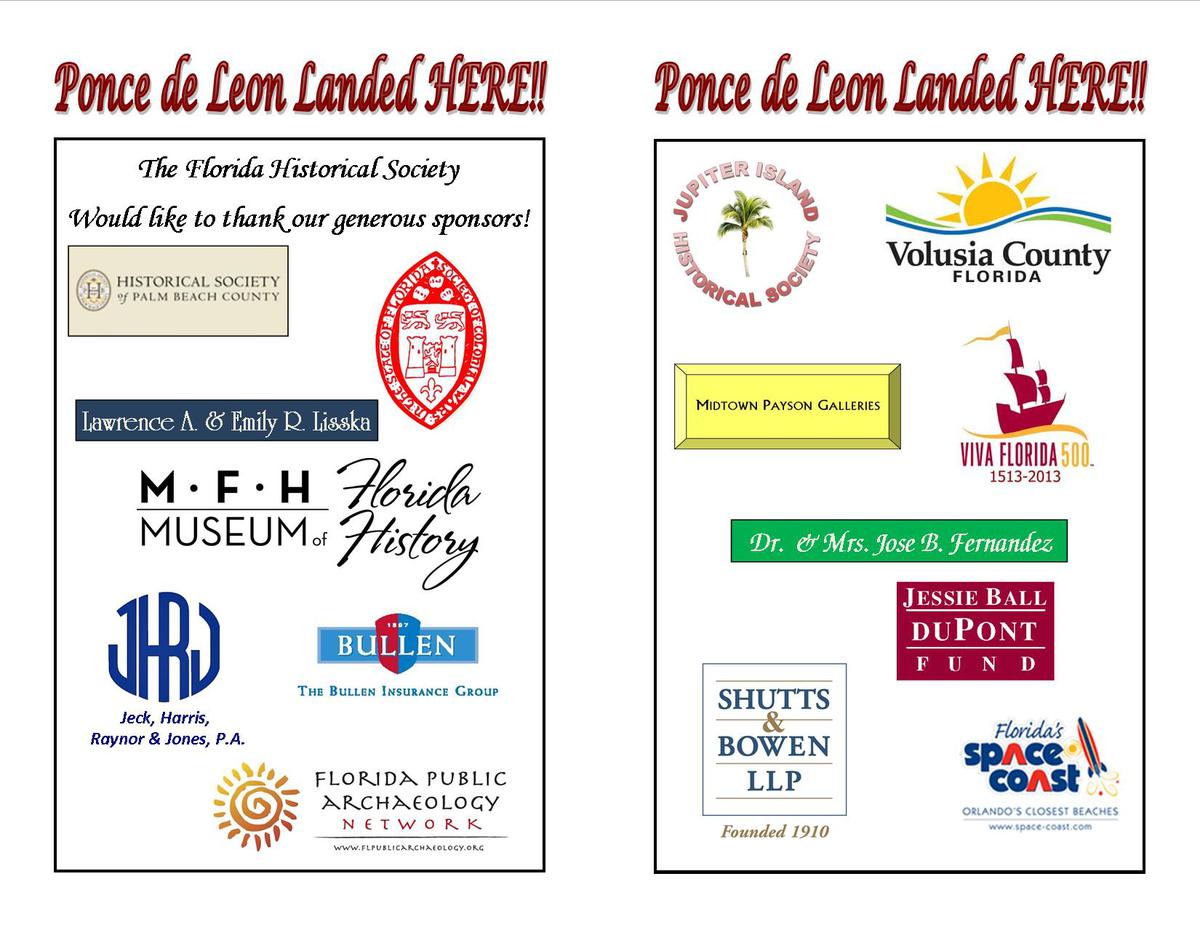Educational Resources
The Florida Historical Society houses a wide array of both primary and secondary source materials from the colonial era to present day tourism trends available to researchers and students. However, when a visit to the library is not optional, our Teacher’s Resource Page will give students and educators the ability to access as much of our archived materials as possible.
CLICK on the below outline links for educational resources.
FHS Classroom Resources
These modules are designed for teachers and students to be able to access and interpret primary sources found at the Library of Florida History. The Florida Historical Society has, for over a century, collected and preserved original documents and records relating to the history of Florida. Yet, the use of original documents in the classroom is often hindered by access to vetted archival repositories. This is an ongoing effort by the Florida Historical Society to create thematic modules which teachers and students are encouraged to download and use in the classroom. These modules are designed for students in grades 4-12, but can be adapted for use in both lower and upper levels. Many of these documents can be utilized outside of the social studies curriculum to connect history with other disciplines.
The first three modules (Slavery in Florida, The Civil War Soldier, and Reconstruction in Florida) in this classroom series were created with financial assistance through a grant from the Florida Council of Social Studies Endowment Board. Special thanks to Heather Pierce for creating much of the content for these first three modules. Additional resources include books published by FHS Press with a guide.
*All documents are housed at the Florida Historical Society Library of Florida History unless otherwise noted.
Click on the below outline links for resources:
Slavery in Florida
As early as the 16th century when Europeans began coming to Florida’s shores, slaves have been an important component of the cultural and social dynamic of the state. By the time Florida became a United States territory in 1821, slavery had become an integral part of the Middle Florida plantation economy. The system of African slavery in Florida was more closely related to other southern states of the time leading up to the American Civil War however. Florida has become part of the great cotton belt which produced a large quantity of the country’s cotton from this slave labor system. This module will focus on the decades leading up to 1861 when slavery had reached its pinnacle in Florida. Students will read and discuss primary documents relating to the institution of slavery in Florida. Each document is accompanied by suggested review questions that will help students engage with the documents in a meaningful way.
Downloads:
Florida's Big Dig
This book is the story of people of vision and courage, of a small group of prominent Saint Augustine investors who conceived of the Florida waterway and began the first dredging work; of an obscure group of New England capitalists who provided significant financing and obtained a million acres of undeveloped Florida public land in pursuing what was, at best, a speculative enterprise; of innumerable citizen groups like the Florida east coast chamber associations and the larger Atlantic Deeper Waterways Association that demanded at the turn of the last century what they believed was the peoples right-a public waterway, free of the burden of tolls; and finally, of the US Army Corps of Engineers, who conducted all of the Florida waterway's early surveys and assumed the project's control in 1929 to convert what was once a private toll way into Florida's modern-day, toll-free Atlantic Intracoastal Waterway.
A TEACHER’S GUIDE TO FLORIDA’S BIG DIG
by William G. Crawford, Jr.
Synopsis: The story of Florida’s Atlantic Intracoastal Waterway from 1881 to 1935: How a privately built toll way became a toll-free public waterway of the federal government.
Click on image or file link near bottom of page to download PDF of teachers guide. The Teacher's Guide is free to use.
The book in both hardback and paperback is availble from the book store of the Florida Historical Society.
PDFfile:
The Civil War Soldier
The Civil War was the bloodiest conflict on American soil. Florida was deeply involved in every aspect of the conflict. Thousands of Floridians fought for both the Union and Confederate Armies and Navies. The primary catalyst for war was the election of President Abraham Lincoln in 1860. Many Floridians feared President Lincoln would abolish slavery, thus upsetting the social and economic system of the state. At the center of this large-scale conflict was the Civil War soldier. Of the thousands of Floridians that went off to war, many never returned. This module focuses on the day to day experiences of soldiers fighting in and outside of Florida’s boundaries, as well as the toll paid by family members these soldiers left behind. Students will be able to build on their previous understanding of the Civil War with supplemental primary materials from those who experienced the conflict first hand.
Downloads:
Forcing Change
It is June 1963 and fifteen-year-old Margaret Jefferson is being arrested at a sit-in at a lunch counter in St. Augustine. The Civil Rights Movement has found its way into her hometown, and Maggie feels a deep need to be a part of it. She believes in the ideals of the movement and the ultimate goal of equality. She also finds the nonviolence that the protestors are committed to very comforting.
However, as the summer and fall of 1963 unfold in St. Augustine, their nonviolent protests are met with rising resistance, aggression, and intimidation from local government officials as well as the Ku Klux Klan. Cattle prods used on protestors, firebombs thrown into the homes of families trying to integrate the schools. teenagers held in jail indefinitely. No one is safe, it seems.
This story, told through Maggie's innocent and hopeful eyes, will help a new generation of young people to understand the strength and sacrifices of those who worked so hard for civil rights in this country. It will also help to shine the spotlight on the role that St. Augustine, and Florida, had in the movement.
Judy Lindquist is the author of the acclaimed historical novel Saving Home, used in classrooms throughout the state to engage students in the study of Spanish colonial St. Augustine. She teaches fourth grade students in Orange County, and aspiring teachers at the University of Central Florida.
PDFfile:
Reconstruction in Florida
The Civil War official ended in April of 1865, yet the county had been torn apart both literally and figuratively. Much of the infrastructure and economy in the southern states were devastated. Tens of thousands of wounded soldiers struggled to return home and return to civilian life but the problem of readmitting the Confederate state back into the Union was complicated and fraught with difficulty. For years after the last shots were fired, many former Confederate states including Florida were under military rule. Politicians from the north occupied public posts which angered many former Confederates. The documents contained in this module examine some of the challengers brought about by Reconstruction. Students will examine firsthand accounts of Reconstruction efforts in Florida from a variety of different angles. Challenge students to understand all sides of this complex part of American history.
Downloads:
Saving Home
“Saving Home is an historical novel set during the English siege of St. Augustine in 1702. The story is told through the eyes of nine-year-old Luissa de Cueva and her friends, ten-year-old Diego de las Alas, and a Timucuan Indian girl named Junco. Based on meticulous research, Saving Home engages readers of all ages with descriptions of Spanish and Native American families seeking refuge for more than six weeks within the walls of the Castillo de San Marcos as St. Augustine goes up in flames and a battle rages around them. This exciting historical novel has messages about life, family, and what is important that will resonate with both the young and the young hearted.”
-Author
Below is a Teachers Guide in pdf format that can be downloaded or viewedon this page
PDFfile:
Video
 The Florida Historical Society has video resources available for education and classroom use. Videos include theatrical, lectures and documentary programs on DVD and digital formats. Many of the videos are available from the Florida Historical Society's You Tube channel: https://www.youtube.com/user/myfloridahistory
The Florida Historical Society has video resources available for education and classroom use. Videos include theatrical, lectures and documentary programs on DVD and digital formats. Many of the videos are available from the Florida Historical Society's You Tube channel: https://www.youtube.com/user/myfloridahistory
For convenient viewing, the youtube videos are also arranged in playlists: https://www.youtube.com/user/myfloridahistory/playlists
Ponce De Leon Landed HERE!!
Ponce deLeon Landed Here was performed live on January 12 at 2pm at the historic Volusia County Courthouse Deland FL., and January 5 at the Historic West Palm Beach Courthouse.
You Tube: https://youtu.be/gU8nuPTjC5Q
Image:
Female Florida: historic women in their own words
An original theatrical production by the Florida Historical Society. Features dramatic portrayals of businesswoman Caroline P. Rossetter, environmentalist Marjory Stoneman Douglas, educator Mary McLeod Bethune, and American folklorist, anthropologist and author Zora Neale Hurston.
The playlist is on the FHS You Tube Channel: https://www.youtube.com/playlist?list=PLExw_eqRv1lAF16Ok4UffMsyfIXPozqgj
A curriculum guide in PDF format is available.
PDFfile:
Discover Florida Lectures
The Discover Florida Lectures bring speakers to the Library of Florida History who approach the issue of "Florida Life and Culture" from a wide range of disciplines, including history, public affairs, law, sociology, criminology, anthropology, literature, music and art. Its overall objective is to create an opportunity for members of the community to listen to, interact with and learn from leading scholars and specialists in the state"s history and culture.
The Florida Historical Society You Tube Channel has a playlist of 11+ lectures at: https://www.youtube.com/playlist?list=PLExw_eqRv1lCf52OjfRNTRJM3wpz_lilT
FHSAI Lecture Series
The Florida Historical Society Archaeological Institute presents lectures and many are recorded on the FHS You Tube Channel.
The You Tube Play List is available at https://www.youtube.com/playlist?list=PLExw_eqRv1lDuEwGkgf0WUTeIwuUcbtgd
OpenSource Artwork
Some of our original artwork and documentation created to promote Florida History is available for download on the Florida Historical Society website, www.myfloridahistory.org
Our vector drawing with the outline of the state of Florida can be used by teachers and authors for illustrations. Some of the materials for download like the mask with the blue palmetto leaf requests some minor restrictions. We request that the blue palmetto leaf to not be used for a commercial book cover since it was commissioned for that.
We request that when you publish using these materials that you give the society credit, refrain from using in direct competition to the original application, and consider the below downloads as permissive"copyleft" under the LGPL license for open source use. It is our intent that this resource be not restricted for publishing by users but also not to be restricted to future users either so while works including the drawings may be copyright, the drawings themselves are copyleft ;).
Blue Palmetto Leaf
 Attached below for download are images an vector drawings of a blue palmetto leaf that was used for a book cover by the Florida Historical Society Press. For education and promotion of Florida History we make the source image with the object mask available for download with the request that it not be used for a published book cover.
Attached below for download are images an vector drawings of a blue palmetto leaf that was used for a book cover by the Florida Historical Society Press. For education and promotion of Florida History we make the source image with the object mask available for download with the request that it not be used for a published book cover.
The original was saved in corel draw 9 with conversions to adobe 'psd' and other formats. If you are enhancing the drawing with additional layers and wish to contribute back, please contact us.
We request that when you use our images that you give the society credit and consider this material a permissive"copyleft" under the LGPL license for open source use. It is our intent that this resource be not restricted for publishing by users but also not to be restricted to future users either so while works including the drawings may be copyright, the drawings themselves are copyleft ;).
Public Files:
| Attachment | Size |
|---|---|
| 33.18 MB | |
| 99.68 MB | |
| 2.77 MB | |
| 2.73 MB | |
| 6.44 MB | |
| 759.87 KB |
Florida Outline
 Attached below for download are drawings for the outline of Florida. While the black and white image (bitmap) of the outline can be useful, the vector drawings of the Florida Outline will allow illustrators to add layers of information to the outline and to resize without the resolution limitations that bitmaps (images) have.
Attached below for download are drawings for the outline of Florida. While the black and white image (bitmap) of the outline can be useful, the vector drawings of the Florida Outline will allow illustrators to add layers of information to the outline and to resize without the resolution limitations that bitmaps (images) have.
The original was saved in corel draw 9 with conversions to adobe illustrator and other formats. If you are enhancing the drawing in Corel Draw with additional layers and wish to contribute back, please contact us.
We request that when you publish that you give the society credit and consider this material a permissive"copyleft" under the LGPL license for open source use. It is our intent that this resource be not restricted for publishing by users but also not to be restricted to future users either so while works including the drawings may be copyright, the drawings themselves are copyleft ;).
Public Files:
| Attachment | Size |
|---|---|
| 127.77 KB | |
| 585.97 KB | |
| 23.67 KB | |
| 44.9 KB | |
| 12.27 KB |
Curriculum Guide for Zora Neale Hurston in Brevard County, FL
Teacher's Curriculum Guide for Zora Neale Hurston in Brevard County, FL in pdf format that can be downloaded here or viewed in the below frame on this page if your web browser supports embedded pdf.
Panel 1, Zora Neal Hurston in Brevard County
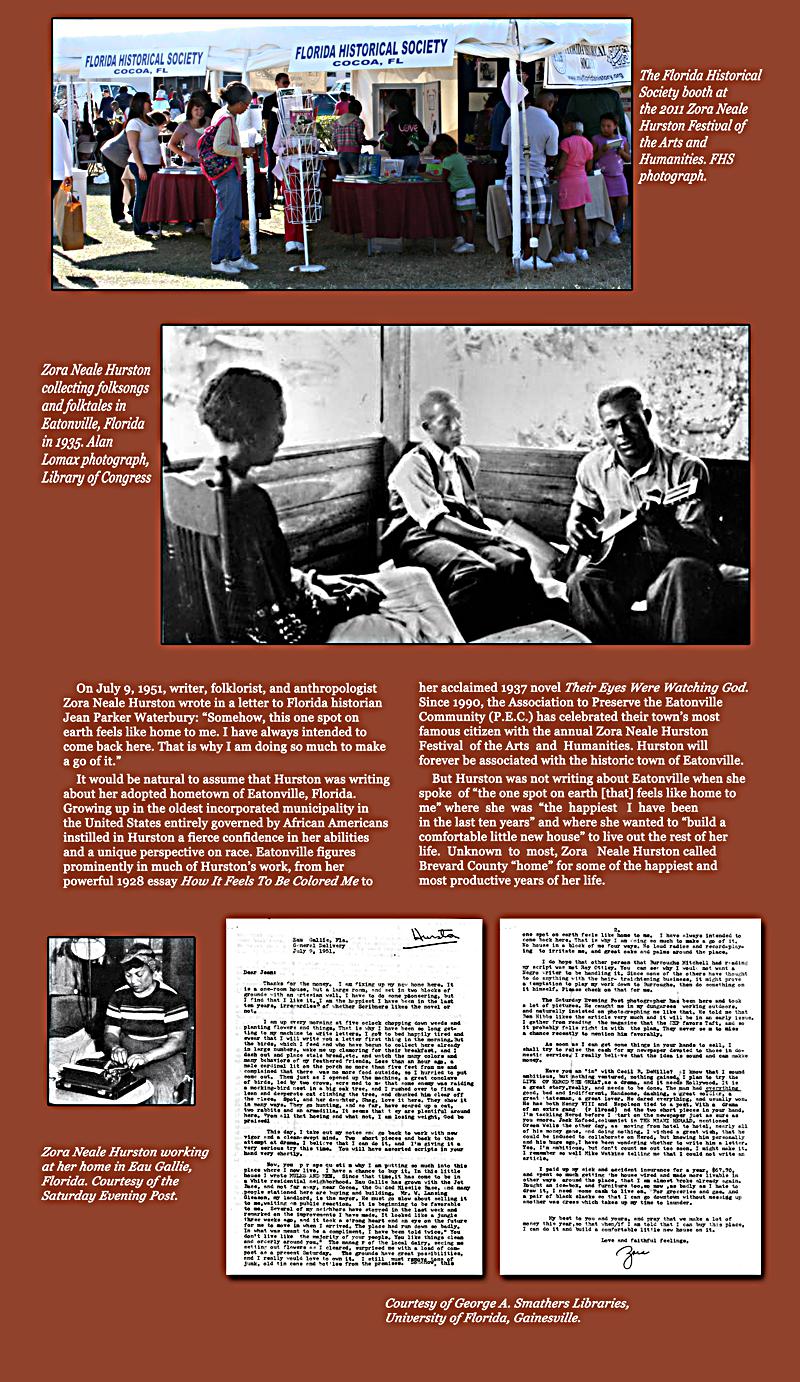
On July 9, 1951, writer, folklorist, and anthropologist Zora Neale Hurston wrote in a letter to Florida historian Jean Parker Waterbury: “Somehow, this one spot on earth feels like home to me. I have always intended to come back here. That is why I am doing so much to make a go of it.”
It would be natural to assume that Hurston was writing about her adopted hometown of Eatonville, Florida. Growing up in the oldest incorporated municipality in the United States entirely governed by African Americans instilled in Hurston a fierce confidence in her abilities and a unique perspective on race. Eatonville figures prominently in much of Hurston’s work, from her powerful 1928 essay How It Feels To Be Colored Me to her acclaimed 1937 novel Their Eyes Were Watching God. Since 1990, the Association to Preserve the Eatonville Community (P.E.C.) has celebrated their town’s most famous citizen with the annual Zora Neale Hurston Festival of the Arts and Humanities. Hurston will forever be associated with the historic town of Eatonville.
But Hurston was not writing about Eatonville when she spoke of “the one spot on earth [that] feels like home to me” where she was “the happiest I have been in the last ten years” and where she wanted to “build a comfortable little new house” to live out the rest of her life.
Unknown to most, Zora Neale Hurston called Brevard County “home” for some of the happiest and most productive years of her life.
Panel 2, Zora Neal Hurston in Brevard County
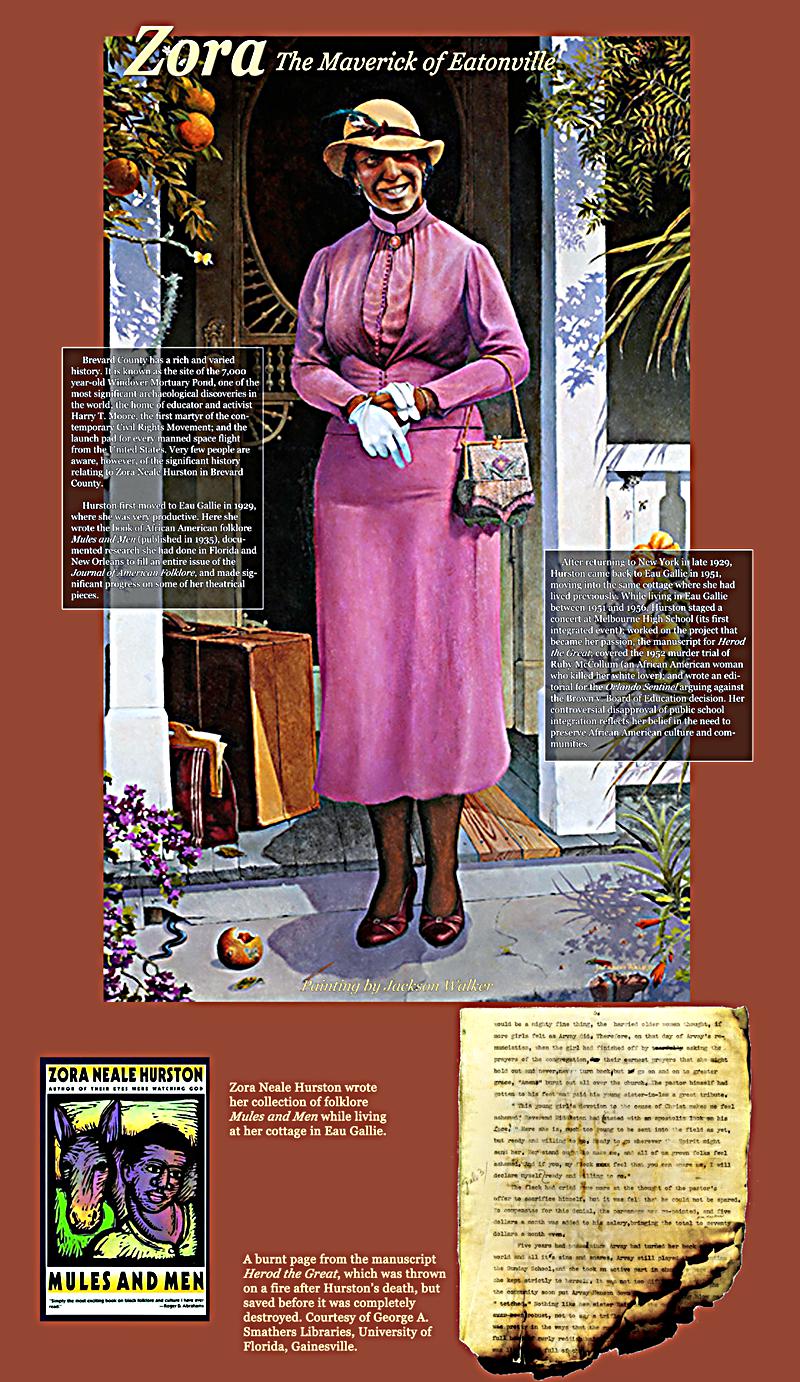
Brevard County has a rich and varied history. It is known as the site of the 7,000 year-old Windover Mortuary Pond, one of the most significant archaeological discoveries in the world; the home of educator and activist Harry T. Moore, the first martyr of the contemporary Civil Rights Movement; and the launch pad for every manned space flight from the United States. Very few people are aware, however, of the significant history relating to Zora Neale Hurston in Brevard County.
Hurston first moved to Eau Gallie in 1929, where she was very productive. Here she wrote the book of African American folklore Mules and Men (published in 1935), documented research she had done in Florida and New Orleans to fill an entire issue of the Journal of American Folklore, and made significant progress on some of her theatrical pieces.
After returning to New York in late 1929, Hurston came back to Eau Gallie in 1951, moving into the same cottage where she had lived previously. While living in Eau Gallie between 1951 and 1956, Hurston staged a concert at Melbourne High School (its first integrated event); worked on the project that became her passion, the manuscript for Herod the Great; covered the 1952 murder trial of Ruby McCollum (an African American woman who killed her white lover); and wrote an editorial for the Orlando Sentinel arguing against the Brown v. Board of Education decision. Her controversial disapproval of public school integration reflects her belief in the need to preserve African American culture and communities.
Panel 3, Zora Neal Hurston in Brevard County
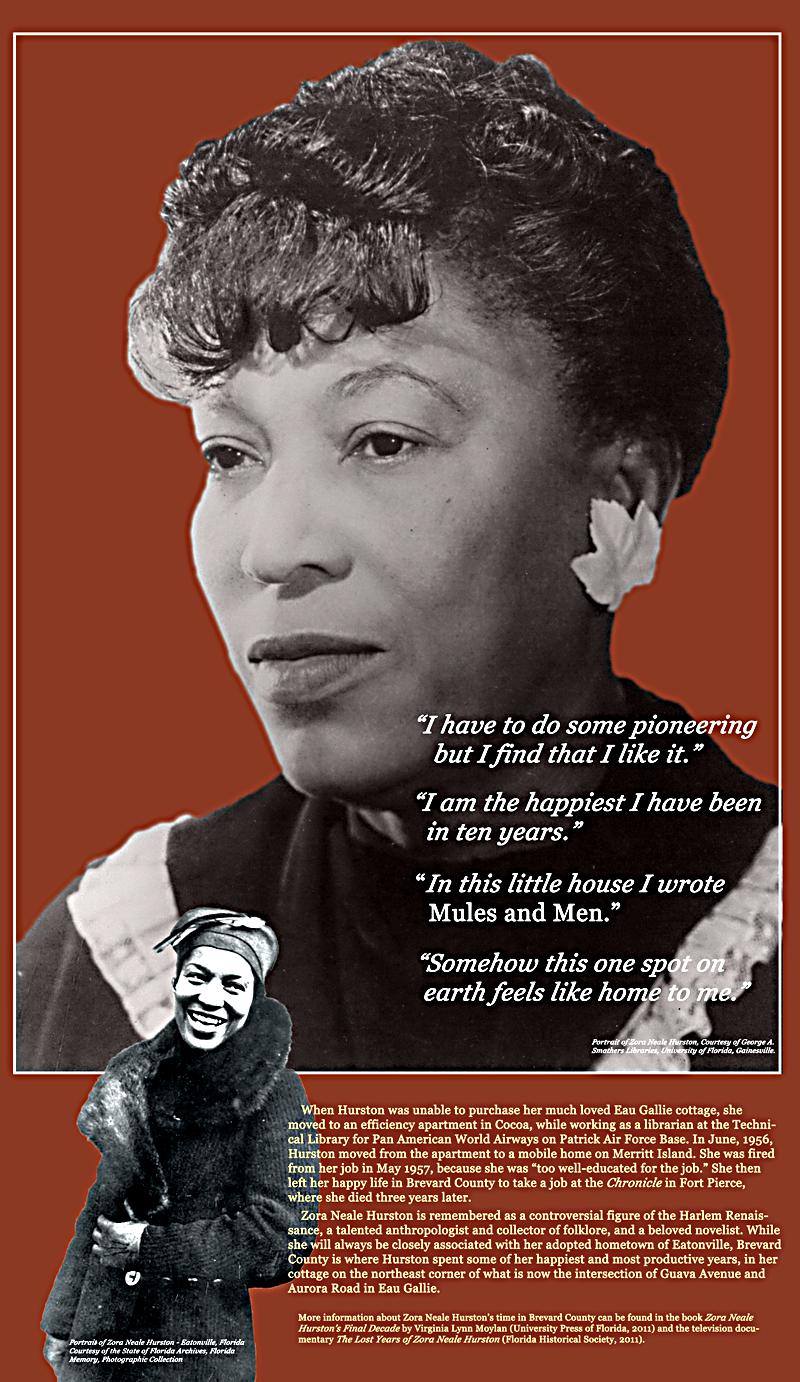
When Hurston was unable to purchase her much loved Eau Gallie cottage, she moved to an efficiency apartment in Cocoa, while working as a librarian at the Technical Library for Pan American World Airways on Patrick Air Force Base. In June, 1956, Hurston moved from the apartment to a mobile home on Merritt Island. She was fired from her job in May 1957, because she was “too well-educated for the job.” She then left her happy life in Brevard County to take a job at the Chronicle in Fort Pierce, where she died three years later.
Zora Neale Hurston is remembered as a controversial figure of the Harlem Renaissance, a talented anthropologist and collector of folklore, and a beloved novelist. While she will always be closely associated with her adopted hometown of Eatonville, Brevard County is where Hurston spent some of her happiest and most productive years, in her cottage on the northeast corner of what is now the intersection of Guava Avenue and Aurora Road in Eau Gallie.
More information about Zora Neale Hurston’s time in Brevard County can be found in the book Zora Neale Hurston’s Final Decade by Virginia Lynn Moylan (University Press of Florida, 2011) and the television documentary The Lost Years of Zora Neale Hurston (Florida Historical Society, 2011).
Panel 4, Zora Neal Hurston in Brevard County
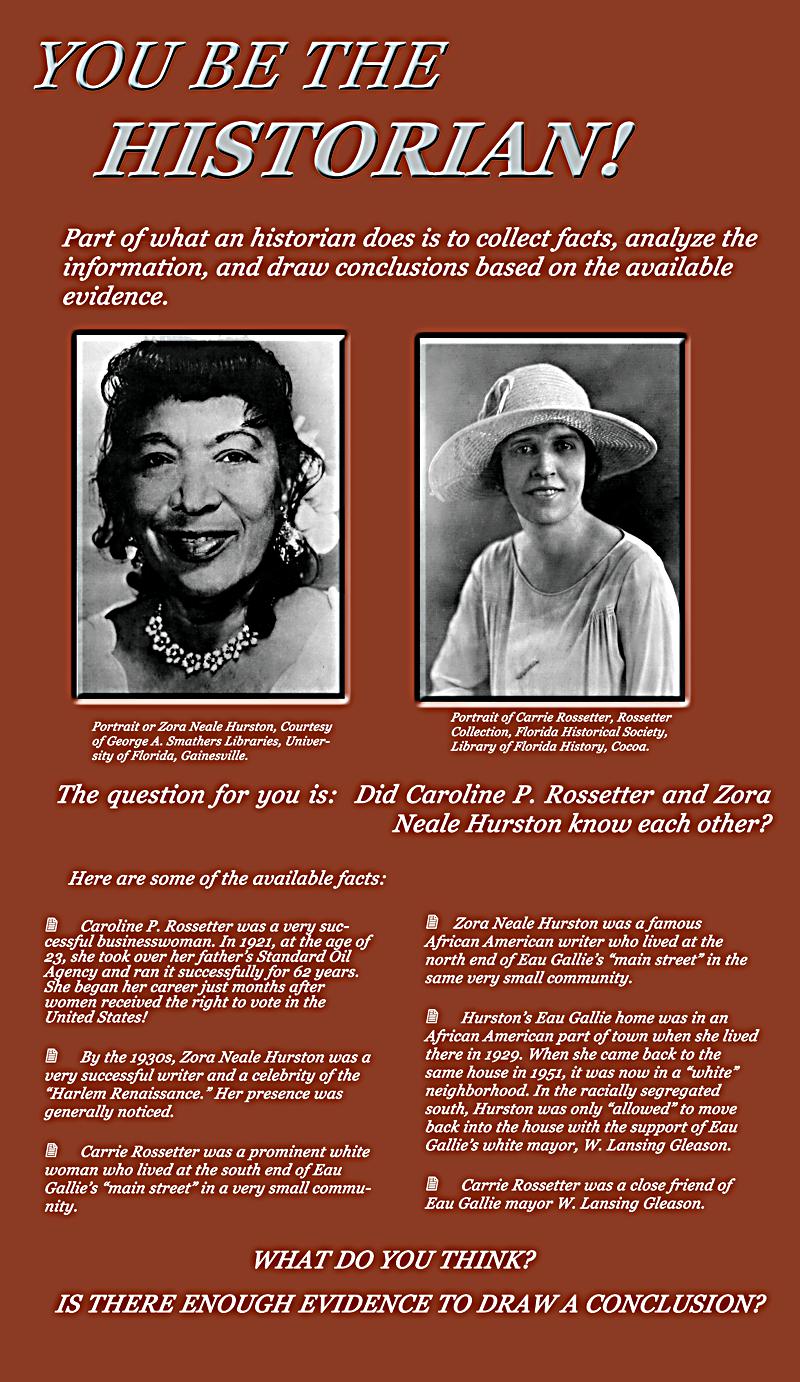
YOU BE THE HISTORIAN!
Part of what an historian does is to collect facts, analyze the information, and draw conclusions based on the available evidence.
The question for you is: Did Caroline P. Rossetter and Zora Neale Hurston know each other?
Here are some of the available facts:
- Caroline P. Rossetter was a very successful businesswoman. In 1921, at the age of 23, she took over her father’s Standard Oil Agency and ran it successfully for 62 years. She began her career just months after women received the right to vote in the United States!
- By the 1930s, Zora Neale Hurston was a very successful writer and a celebrity of the “Harlem Renaissance.” Her presence was generally noticed.
- Carrie Rossetter was a prominent white woman who lived at the south end of Eau Gallie’s “main street” in a very small community.
- Zora Neale Hurston was a famous African American writer who lived at the north end of Eau Gallie’s “main street” in the same very small community.
- Hurston’s Eau Gallie home was in an African American part of town when she lived there in 1929. When she came back to the same house in 1951, it was now in a “white” neighborhood. In the racially segregated south, Hurston was only “allowed” to move back into the house with the support of Eau Gallie’s white mayor, W. Lansing Gleason.
- Carrie Rossetter was a close friend of Eau Gallie mayor W. Lansing Gleason.
WHAT DO YOU THINK? IS THERE ENOUGH EVIDENCE TO DRAW A CONCLUSION?

